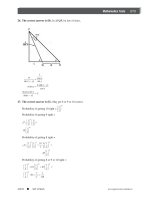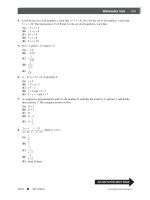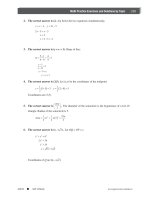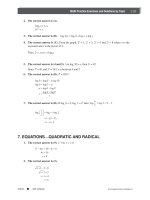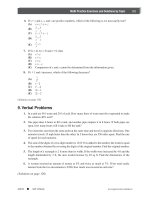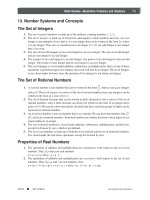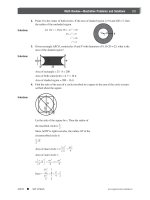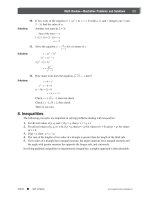SAT II Biology Episode 1 Part 6 pptx
Bạn đang xem bản rút gọn của tài liệu. Xem và tải ngay bản đầy đủ của tài liệu tại đây (340.61 KB, 20 trang )
Monohybrid does not refer to the fact that each member involved in
the cross need be hybrid. It refers to the fact that individuals homozy-
gous for both the dominant and the recessive trait, when crossed,
will result in hybrids. Another way to say it is that monohybrid
crosses reflect one of each trait, the dominant and the recessive. We
also use this to refer to a hybrid individual who has one dominant
allele and one recessive allele. The classic monohybrid results of a
phenotypic ratio of 3:1 and genotypic ratio of 1:2:1 are noted below.
GENETICS—MENDEL AND HEREDITY
97
Peterson’s n SAT II
Success: Biology E/M www.petersons.com
DIHYBRID CROSSES
A cross potentially hybrid for two traits, dihybrid crosses still hold
true to Mendel’s laws; there are simply more gametes possible and
more offspring (illustrated above). The typical true genotypic ratio is
cumbersome to note here, although it is illustrated, and the typical
true dihybrid phenotype ratio is the classic 9:3:3:1. If the traits are A
or a and B or b, the phenotypic nine would produce all AB appear-
ing, the first three might be Ab appearing, making the second three
aB appearing, and the one would be represented by ab appearing
individuals.
INCOMPLETE DOMINANCE
Characteristics intermediate between parental extremes are shown;
the traits combine to produce an intermediate form indicating that
neither is dominant, thus the name. Instead of making up a new
symbol to indicate the third trait, it is illustrated by showing it as
CHAPTER 4
98
Peterson’s n SAT II
Success: Biology E/Mwww.petersons.com
being made up of one each of the two alleles in question, as illus-
trated. Care should be taken on questions referring to incomplete
dominance. The greater number of “blended” offspring would be
given not by a cross between two of these individuals but by crossing
individuals pure for the component alleles. If R represents red in
four-o’clock flowers, W represents white, and RW represents pink,
the largest number of pink flowers would come from mating a red
[RR] and a white [WW] four-o’clock flower plant. By Mendel’s laws,
all of the offspring would be RW.
MEIOSIS
Meiosis refers to stages in the life of cells as they prepare to pass on
their traits to the next generation. Meiosis has two divisions in
contrast to the one division of mitosis. Meiosis is often referred to as
a reduction division. Meiosis is the embodiment of Mendel’s Law of
Segregation. As will be seen, this is where crossing over, nondisjunc-
tion, and the like do matter. A chromosome is composed of two
identical “sister” chromatids. They are identical to each other and are
in fact duplicates. Only one half is present in the normal workings of
the cells. An exact copy is made and attached to its “sister” half
during interphase in order to prepare for the division about to occur.
CELL TYPES
When referring to cells and their division in meiosis, we use two
terms, depending on how many of the necessary compliment of
chromosomes each cell has. One refers to the number we typically
find in body, or somatic, cells, and the other is used to refer to the
number of chromosomes found in the sex cells located in the primary
sex organs, or gonads, of the female (the ovaries) or the male (the
testes).
Haploid
Haploid refers to half the number of chromosomes normally found in
the body cells of an individual. This number is achieved through
meiosis and occurs mainly in all cells, with the exception of plants,
that are ready for reproduction. Sexual reproduction brings the cell
back to the diploid number.
Diploid cells
Diploid refers to the normal chromosomal number found in the body
cells of individuals capable of sexual reproduction. Also found in the
sex cells prior to meiosis.
GENETICS—MENDEL AND HEREDITY
99
Peterson’s n SAT II
Success: Biology E/M www.petersons.com
STAGES
Meiosis goes through two divisions, with the stages named after
similar stages found in mitosis but labeled withaIorII.Condensa-
tion of the chromosomes occurs and they migrate to the middle of
the cell, are separated, and migrate to opposite ends of the cell. This
is where the similarity ends between mitosis and meiosis.
Meiosis I
Following the disappearance of the nuclear envelope, chromosomes
begin to condense, and homologous pairs lie next to each other in a
manner similar to mitosis. The way in which they line up and what
can happen to them, however, is very different in meiosis I.
CHAPTER 4
100
Peterson’s n SAT II
Success: Biology E/Mwww.petersons.com
A. Prophase I
Homologous pairs begin to line up next to each other as pairs—not
as individuals as in mitosis—in a process called synapsis. This makes
four entities, which explains why they are called tetrads at this point.
Homologous pairs are biochemically very similar: the genetic code for
blue eyes versus brown eyes starts in exactly the same way, although
the code for those colors is chemically different beyond those starting
points. If these closely associated segments, by virtue of their
chemistry, happen to intertwine in close proximity, they may
exchange parts in a process called crossing over. Occasionally,
homologous pairs do not separate, or they separate inconsistently in a
process know as nondisjunction. This will most likely cause more
information to be passed on in one or more of the resulting sex cells.
GENETICS—MENDEL AND HEREDITY
101
Peterson’s n SAT II
Success: Biology E/M www.petersons.com
B. Metaphase I
Tetrads line up along the equator in the middle of the cell as in
mitotic metaphase. Once again, they are lined up as pairs, not as
individual chromosomes as in mitosis. Spindles are attached to the
centromeres, and the homologous pairs are about to be separated,
which provides the basis for the variation noted in the Law of
Independent Assortment.
C. Anaphase I
The homologous pairs of each tetrad begin migrating to opposite
ends of the cell, similar to mitosis. At this point, the number of
chromosomes in each forming cell is reduced by half.
CHAPTER 4
102
Peterson’s n SAT II
Success: Biology E/Mwww.petersons.com
D. Telophase I
The nuclear envelope reforms around each set of chromosomes and
the cells divide (cytokinesis).
Meiosis II
This part of meiosis is almost identical to mitosis, except it uses only
one half of the tetrad.
A. Prophase II
Chromosomes condense and become visible as sister chromatids
attached at the centromere, but only as half the number of normal
homologous pairs.
B. Metaphase II
The chromosomes line up along the equator of the cell.
C. Anaphase II
The chromosomes split at the centromeres and begin migrating to
opposite ends of the cell.
D. Telophase II
The nuclear envelope reforms, and the result is four haploid cells.
GENETICS—MENDEL AND HEREDITY
103
Peterson’s n SAT II
Success: Biology E/M www.petersons.com
GAMETOGENESIS
Oogenesis
In females, gametogenesis produces eggs, or ova, and is called
oogenesis. For every diploid cell that undergoes gametogenesis in
females, one egg is produced. In oogenesis, the other three cells
receive very little cytoplasm and eventually degenerate in a move that
conserves cytoplasm for the surviving cell.
CHAPTER 4
104
Peterson’s n SAT II
Success: Biology E/Mwww.petersons.com
Spermatogenesis
In males, gametogenesis produces sperm and is called spermatogen-
esis. For every diploid cell that undergoes gametogenesis in males,
four sperm are produced.
CHROMOSOME INTERACTIONS
During the course of both mitosis and meiosis, the chromosomes
come in proximity and, since they are composed of similar chemical
material, they may interact. The bulk of this section is spent on the
matter at hand, namely meiosis.
Mitosis
In body cells, there is no risk of what the next generation of individu-
als will receive as genetic information. Any interaction of chromo-
somes in mitosis, other than what usually should happen, will lead
the cells to die off or pass on the anomaly, called a mutation, which
is usually negative. (NOTE: If a cell is currently functioning properly,
any change will most likely result in a problem with that function-
ing.) If the cell survives the interaction, it will most likely be the
result of a mutation that makes it different than the surrounding cells
and thus, in all likelihood, a competitor. If the new anomalous cell is
better at surviving than the surrounding cells, it will crowd them out,
becoming what is known as cancerous.
GENETICS—MENDEL AND HEREDITY
105
Peterson’s n SAT II
Success: Biology E/M www.petersons.com
Meiosis
In meiotic chromosomal interactions, the danger is that negative
interactions may be passed on to future generations. The mutations
result in a variety of well-known conditions. The future may hold
more or fewer, and it is anybody’s guess.
A. Epistasis
When one gene masks the expression of another gene (e.g., if the
first gene codes for the absence of a trait), as in no pigmentation,
then the expression of the second gene, which may code for the kind
of pigmentation, has no effect.
B. Multiple alleles
Expression of a trait is controlled by the presence of more than two
alleles, as in the case of blood types A, B, AB, and O. The alleles for
blood types A and B (represented by I
A
and I
B
, respectively) are
separately dominant. Together they are incompletely dominant as in
AB (represented only by I
A
I
B
) blood type. Blood type O (repre-
sented by i) is recessive. If the two alleles are I
A
I
A
or I
A
i, then the
dominate blood type will be A. If the two alleles are I
B
I
B
or I
B
i,
then the dominate blood type will be B. Type O blood can only be ii.
The interactions of these alleles, which produce an easily identifiable
trait, is the first line of investigation in verifying the parents of a baby,
if it actually comes into question, as has occurred in the past in
hospital mix-ups.
C. Pleiotropy
Occurs when a gene has more than one phenotypic expression.
D. Polygenic inheritance
Rather than producing clearly defined phenotypes, polygenic inherit-
ance involves a continuum of genetic variation that is controlled by
many genes, as the name suggests.
CHAPTER 4
106
Peterson’s n SAT II
Success: Biology E/Mwww.petersons.com
E. Linked genes
If two genes are on the same chromosome, they are linked. The
mapping of (or the percent probability of spacing between and even
the sequence of) these genes on the chromosome can be determined
through the frequency with which crossing over occurs. One
well-known instance of linkage is the universe of traits that is known
as sex-linked. While these show up, as a rule, in a higher percentage
of males, the sex-linked trait resides on the sex cell (gamete). In
essence, the gene on the X chromosome has no counterpart on the
male or Y chromosome, making the gene on the X chromosome
dominant by default. Sex linkage is illustrated by, as in the case of
hemophilia, X
N
where the N represents the allele for normal blood
and X
n
would represent an X chromosome with the n allele for
hemophilia. Thus X
N
X
N
and X
N
X
n
would represent two females
with normal blood, and the latter would be known as a carrier, able
to pass on the gene but as a phenotype. A female with the genotype
X
n
X
n
would be a hemophiliac. A male with the genotype X
N
Y
would be expressing a normal blood phenotype, and a male inherit-
ing X
n
Y would be a hemophiliac, which is a rare condition. Several
Punnett squares illustrating these interactions are noted on the next
page. Note that females are likely to be color blind 33 percent of the
time while males are likely to be color blind 50 percent of the time
in these interactions. This is also illustrated on the following page.
GENETICS—MENDEL AND HEREDITY
107
Peterson’s n SAT II
Success: Biology E/M www.petersons.com
F. Nondisjunction
Occurs when chromosomes do not properly separate during meiosis
as they migrate to opposite poles. Down’s syndrome or Trisomy 21 is
an example of this and is easily identified through amniocentesis, an
examination of the baby’s cells—the only ones present—in the
amniotic fluid.
CHAPTER 4
108
Peterson’s n SAT II
Success: Biology E/Mwww.petersons.com
MULTIPLE-CHOICE QUESTIONS
1. Which of the following is NOT indicated by Mendel’s experi-
ments?
(A) incomplete dominance
(B) segregation
(C) recessive
(D) dominant
(E) independent assortment
2. A ratio of 3:1 in the phenotype of an organism occurs when
(A) the alleles are incompletely dominant.
(B) only recessive traits are involved.
(C) only dominant traits are involved.
(D) alleles segregate during meiosis.
(E) crossing over has occurred in Anaphase II.
3. Colorblindness in humans is
(A) caused by a recessive allele.
(B) in equal proportion in both sexes.
(C) caused in females by a heterozygous genotype.
(D) inherited by males from their male parent.
(E) caused in males by a homozygous genotype.
4. Trisomy 21 in humans is the result of
(A) pleiotropy.
(B) polygenic inheritance.
(C) epistasis.
(D) x-inactivation.
(E) nondisjunction.
5. Homologous chromosomes line up in pairs in
(A) metaphase of mitosis.
(B) metaphase I.
(C) metaphase II.
(D) interphase.
(E) prophase of mitosis.
GENETICS—MENDEL AND HEREDITY
109
Peterson’s n SAT II
Success: Biology E/M www.petersons.com
6. In a heterozygous monohybrid cross, the dominant trait can be
expressed in the phenotype of the F1 ________ of the time.
(A) 0 percent
(B) 25 percent
(C) 33 percent
(D) 75 percent
(E) 100 percent
7. Which of the following would be the result of a true dihybrid
cross?
(A) AABB
(B) AABb
(C) AaBb
(D) AaBB
(E) aaBb
8. Which of the following would indicate a test cross, where T
represents the dominant, tall, trait and t represents the recessive,
short, trait?
(A) Tall × TT
(B) Tall × Tt
(C) Tall × tt
(D) TT × Tt
(E) short × tt
9. __________ refers to one gene affecting many traits.
(A) Polygenesis
(B) Pleiotropy
(C) Linkage
(D) Epistasis
(E) Nondisjunction
10. Which of the following blood types are possible if the parents
are A and O blood types?
(A) A and O
(B) B and O
(C) AB only
(D) O only
(E) A, B, and O
CHAPTER 4
110
Peterson’s n SAT II
Success: Biology E/Mwww.petersons.com
EXPLANATION OF ANSWERS FOR MULTIPLE-CHOICE QUESTIONS
1. The correct answer is (A). The only choice that represents
non-Mendelian genetics would be choice (A). The interaction of
traits that blend would have been much harder to delineate
without first knowing the laws that Mendel proposed. Being the
mathematician that he was, Mendel reduced the number of
variables to easily interpretable parameters. Choices (B) through
(E), of course, reflect his laws: choice (B) represents the Law of
Segregation, choices (C) and (D) represent the Law of Domi-
nance, and choice (E) represents the Law of Independent
Assortment.
2. The correct answer is (D). A phenotypic ratio of 3:1 is
expressed only where there is the presence of a dominant allele
in both individuals and a recessive allele in both individuals; they
are hybrids. More important, though, is the fact that these alleles,
in order to produce all possible combinations, must segregate in
a process we now know as meiosis. This results in offspring with
1-TT genotype, 2-Tt genotypes, and 1-tt genotype. It produces a
phenotype ratio of three dominant-expressing individuals and
one recessive-expressing individual for every four offspring. A 3:1
ratio cannot occur in incomplete dominance. If only recessive or
only dominant alleles are involved, the ratios would respectively
be 100 percent and 100 percent. Crossing over cannot be
detected using this ratio.
3. The correct answer is (A). Colorblindness is caused by a
recessive allele on the X chromosome. It is not found in equal
proportion in both sexes: Females are 33 percent likely to be
colorblind and must inherit a colorblind–carrying X chromosome
from both parents, but males are 50 percent likely to be color-
blind as they only need to inherit one colorblind–carrying X
chromosome from their mothers. A heterozygous female will be
a carrier; she possesses one of the genes and has no colorblind-
ness, but in order to be colorblind, she must be homozygous for
the recessive trait. Since the male inherits only a Y chromosome
from his father, he cannot inherit colorblindness from his father.
Finally, males do not have homozygous sex chromosomes;
therefore, colorblindness is not a male-only trait. The homozy-
gous genotype would only be in the female.
4. The correct answer is (E). Pleiotropy is one gene controlling
many traits, and polygenic inheritance is the opposite of this.
Epistasis is one gene affecting one other gene in its expression.
X-inactivation occurs in mammals when one X chromosome stays
coiled up and is known as a Barr body. The other one functions
as the active chromosome. The coiled up autosome has become
GENETICS—MENDEL AND HEREDITY
111
Peterson’s n SAT II
Success: Biology E/M www.petersons.com
inactive. Trisomy 21 occurs when the twenty-first pair of
chromosomes separates incorrectly during meiosis, which is
known as nondisjunction.
5. The correct answer is (B). In meiosis, the homologous pairs
line up as individuals in meiosis I in preparation for final segrega-
tion in meiosis II. Meiosis simply needs to ensure the pairs end
up in opposite daughter cells in meiosis I. It is in mitosis that the
homologous pairs line up as pairs, and interphase, of course, is
not a phase where the chromosomes even appear.
6. The correct answer is (D). In a heterozygous cross—height,
for example, when T represents the dominant, tall, trait and t
represents the recessive, short, trait—the following genotype
would represent both parents: Tt. Following Mendelian proce-
dures and using a Punnett square to ensure accuracy, the
following genotypes would result: TT, Tt, Tt, and tt. This would
produce an occurrence of the dominant trait 75 percent of the
time.
7. The correct answer is (C). The use of the word “true” dihybrid
indicates that the test maker wants hybrid expression for both
traits, which means the presence of all possible alleles in the
genotype; this only appears in choice (C). Choices (B) and (D)
are dihybrids, but not true dihybrids for both traits.
8. The correct answer is (C). A test cross occurs where a
recessively expressed phenotype (which is therefore homozygous
in genotype) is used to detect the likelihood of a recessive allele
being masked by a dominant allele. If the recessive is crossed
with a pure dominant, there is no chance of the recessive trait in
the phenotype of the F1. If, on the other hand, there is a
recessive allele being masked by a dominant allele, it has the
potential of showing up no less than 50 percent of the time in
the phenotype of the F1.
9. The correct answer is (B). Our definition of one gene affecting
many traits is, of course, called pleiotropy and occurs in in-
stances such as several disease-causing alleles. Sickle-cell anemia
is one such condition. The “sickling” or collapse of the RBCs
results in effects in other parts of the body. Polygenesis is the
opposite and would be found in such instances as height in
humans, where a group of genes results in a continuum of
heights. Epistasis is one gene affecting one other gene in its
CHAPTER 4
112
Peterson’s n SAT II
Success: Biology E/Mwww.petersons.com
expression. Nondisjunction occurs when a pair of chromosomes
separate incorrectly during meiosis.
10. The correct answer is (A). This is a case of multiple alleles
controlling a trait (not to be confused with polygenesis). The
alleles for blood types A and B (represented by I
A
and I
B
,
respectively) are separately dominant, when one is present but
the other is not. Taken together, they are incompletely dominant
as in AB (represented only by I
A
I
B
) blood type. Blood type O
(represented by i) is recessive. If the two alleles are I
A
I
A
or I
A
i, then the blood type will be A. If the two alleles are I
B
I
B
or
I
B
i, then the blood type will be B. Type O blood can only be ii.
GENETICS—MENDEL AND HEREDITY
113
Peterson’s n SAT II
Success: Biology E/M www.petersons.com
VOCABULARY
alleles
autosomes
carrier
chromatin
codominance
color blindness
crossing over
dihybrid cross
diploid cell
dominant
F2 generation
filial (F) generation
gametes
gametogenesis
genes
genotype
germ cells
gonads
Gregor Mendel
haploid cell
hemophilia
heterozygous
homologous chromosomes
homozygous
incomplete dominance
Law of Dominance
Law of Independent Assortment
Law of Segregation
meiosis
monohybrid cross
oogenesis
ovaries
parent (P1) generation
phenotype
polygenic inheritance
Punnett square
recessive
sex cells
sex chromosomes
sex-linked traits
sister chromatids
spermatogenesis
spindle fibers
synapsis
test cross
testes
tetrad
trait
CHAPTER 4
114
Peterson’s n SAT II
Success: Biology E/Mwww.petersons.com
Chapter 5
MOLECULAR GENETICS—DNA AND
EVOLUTION
OVERVIEW
DNA controls the life of the cell by controlling the manufacture of
proteins and is the material of the genes that are integral parts of the
chromosomes. These proteins are used either to make other mol-
ecules or to form part of the structural network of the cell. DNA even
makes the proteins that control the functions of DNA itself as well as
controlling heredity. Watson and Crick are credited with first express-
ing the structure of DNA. You will find test questions on both the
structure and function of DNA as well as RNA and the molecules
involved in protein synthesis. DNA is now known to be a double
helix in its non-replicating state.
The code for life resides in the sequence of nucleotides along the
length of the molecule. The foundation of evolution is change that
comes about through the interaction of an organism’s unique cellular
115
Peterson’s n SAT II
Success: Biology E/M www.petersons.com
DNA with the organism’s environment. For this reason, we include
material on evolution coupled with the material on DNA. Since the
function of DNA is to pass on traits from generation to generation,
and we have explored heredity, we now explore the details of how
this information is passed on. As we have stated before, the student
should be familiar with the material outlined in this book and related
material as well. We begin with the structure of DNA.
DNA
DNA is a biochemical molecule responsible for passing on the traits
of an organism, which include controlling the biochemical nature and
function of that organism. DNA is a double helix molecule that
achieves a great deal of compacting in the nucleus by coiling in on
itself many times. DNA makes RNA, which carries the code to the
cytoplasm. There, ribosomes are utilized in making polypeptide
chains that are proteins. Both the lack of an oxygen on the ribose
sugar—thus the name deoxyribose nucleic acid—and the presence of
the base thymine serve to prevent DNA from leaving the nucleus.
CHAPTER 5
116
Peterson’s n SAT II
Success: Biology E/Mwww.petersons.com


